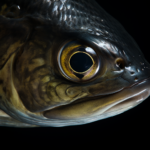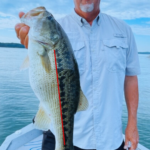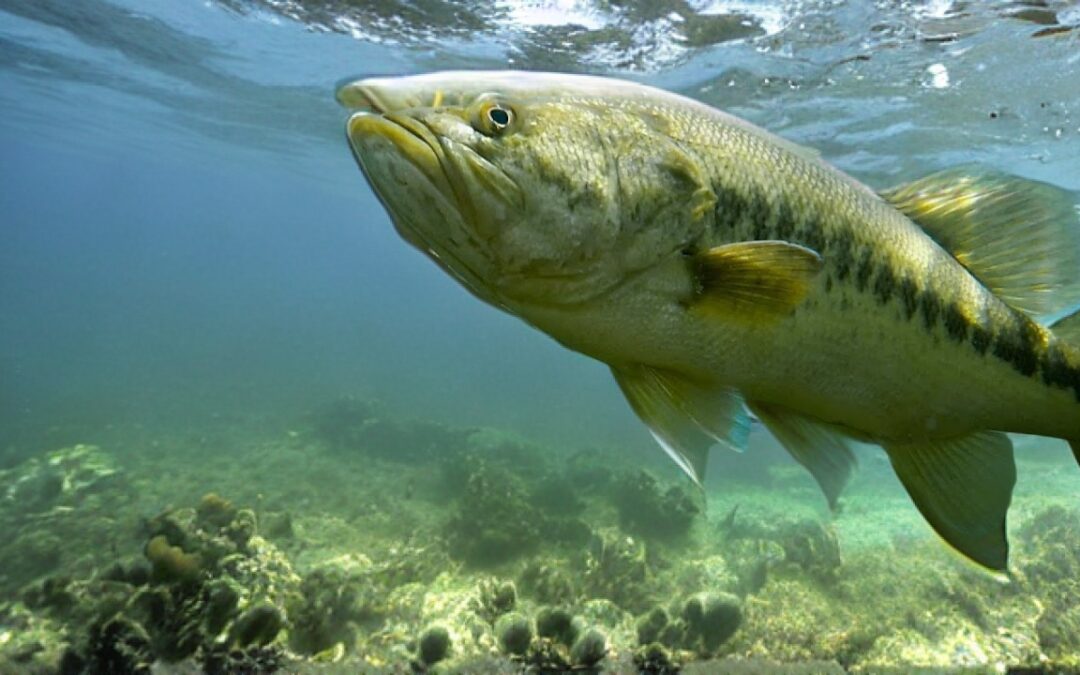Bass fish rely on their sensory experiences to navigate their environment and locate prey. Understanding how they perceive their surroundings can help you trigger more bites. We are speaking of spots particularly, but these facts hold true for all species in the black bass family, including largemouth, smallmouth, and spotted bass. Here’s an overview of the senses of bass and how you can appeal to them:
 Vision
Vision
Bass have excellent vision and rely on it to detect movement, distinguish colors, and identify prey.
Bass have superb vision and rely on it to recognize colors, sense movement, and locate prey.
In order to find and follow their prey, spotted bass, rely on their highly developed vision. Their vision and how they employ it are described as follows:
Black bass have exceptional visual acuity, which enables them to perceive motions and small details clearly. They have large fields of vision and good depth awareness thanks to the placement of their eyes on the sides of their heads. They can now see possible prey across a larger region thanks to this.
Color Vision: Black bass have color vision and can distinguish a wide range of colors. They are particularly sensitive to shades of red, orange, and chartreuse, which are commonly found in the natural colors of their prey. This color perception helps them identify and target specific prey species.
Low-Light Adaptation: Bass have adapted to low-light conditions, such as early mornings, evenings, and overcast days. They possess a higher number of light-sensitive cells called rods, which allow them to see well in low-light situations. This adaptation enhances their ability to locate and pursue prey during low-light periods.
Spotting Prey: Bass use their vision to spot movement and detect prey. They keenly observe their surroundings, looking for signs of activity such as baitfish swimming, small creatures moving near the surface, or disturbances in the water caused by potential prey. Once they spot a target, they may stalk it, assessing its behavior and positioning themselves for an attack.
Ambush Predators: Bass are known as ambush predators, relying on their visual acuity to pinpoint potential prey and set up ambushes. They often position themselves near structures, vegetation, or other cover where prey is likely to pass by. Their ability to detect subtle movements and differences in light and shadow helps them remain hidden until they launch a rapid attack.
Strike Accuracy: Bass have precise strike accuracy due to their keen vision. They can calculate distances and adjust their movements accordingly to intercept prey effectively. Their ability to focus on specific targets and track them allows them to make precise strikes and improve their success rate when feeding.
Overall, the sense of vision is crucial for black bass to locate and target their prey. Their excellent visual acuity, color vision, low-light adaptation, and ability to spot movement enable them to identify potential food sources, set up ambushes, and execute precise strikes. Understanding how bass utilize their vision can help anglers select lures and presentations that mimic natural prey and trigger feeding responses from these visually driven predators.
To appeal to their vision:
Use lures that have realistic colors, patterns, and details mimicking the prey they commonly feed on.
Experiment with different lure sizes and shapes to match the forage in the waterbody you’re fishing.
Opt for lures with contrasting colors or flashy accents to catch their attention.
 Hearing
Hearing
Bass have a highly sensitive lateral line system, which allows them to detect subtle vibrations and sound waves in the water.
Lateral Line System: Black bass have a sensory organ called the lateral line system, which runs along the sides of their bodies. This system consists of a series of tiny sensory hair cells that can detect vibrations and changes in water pressure.
Detecting Vibrations: The lateral line system allows bass to detect subtle vibrations created by the movements and activities of nearby prey. When prey, such as baitfish or invertebrates, swim or make rapid movements, they create water disturbances that are sensed by the bass.
Locating Prey: By detecting vibrations in the water, bass can pinpoint the location and direction of potential prey. They use this information to home in on their prey’s position and plan their attack accordingly.
Ambush Predation: Black bass are known for their ambush predation strategy, where they lie in wait and strike swiftly at passing prey. Their sense of hearing aids in this strategy by allowing them to detect the movements and vibrations of prey swimming nearby, even if the prey is out of their direct line of sight.
Reactive Strikes: Bass may also react to sound stimuli when hunting for prey. They may respond to sounds that mimic the movements or distress calls of their prey. For example, anglers use lures with rattles or vibrating features to attract bass by creating noise and vibrations that mimic injured or fleeing prey.
Environmental Awareness: The sense of hearing also helps bass become aware of their surroundings. They can detect the splashing sounds of other fish feeding, the movement of other bass, or disturbances caused by potential threats. This awareness helps them assess their environment and make decisions regarding feeding and potential dangers.
It’s important to note that while the sense of hearing is present in black bass, their reliance on it for locating prey is secondary to their highly developed sense of vision. Nonetheless, their ability to detect vibrations and changes in water pressure through the lateral line system contributes to their overall sensory perception and enhances their hunting efficiency in specific situations.
To appeal to their hearing:
Incorporate lures with rattles or vibrating features that create noise and attract attention.
Experiment with different retrieve speeds and variations to produce vibrations that mimic injured or fleeing prey.
Pay attention to the sounds you make on the boat or shoreline, as loud noises can spook fish.
Scent
While bass do not have a highly developed sense of smell compared to some other species, they can detect certain scents or odors in the water.
Black bass, including largemouth, smallmouth, and spots, possess a sense of smell, although it is not as well-developed as some other fish species. While their sense of smell is not their primary sensory mechanism for locating prey, it can still play a role in their feeding behavior. Here’s a description of bass sense of smell and how they use it:
Olfactory Organs: Black bass have olfactory organs, located in their nostrils or nares. These organs contain sensory receptors that detect chemical cues present in the water.
Detecting Chemicals: The olfactory receptors in black bass can detect chemical substances dissolved in the water, including scents released by potential prey, injured prey, or specific environmental cues.
Baitfish and Prey Odors: Black bass can pick up on the odors released by baitfish, such as shad, minnows, or other forage species they commonly feed on. They use these scent cues to locate schools of baitfish and potential hunting opportunities.
Scent Trails: Bass may follow scent trails left by injured or distressed prey. When prey species release chemicals into the water due to injury or stress, bass can pick up on these scent cues and home in on the weakened prey.
Water Conditions: Black bass can also detect changes in water chemistry, such as temperature, pH, or dissolved oxygen levels, through their olfactory senses. These cues can help them locate areas with optimal conditions for feeding.
To appeal to their sense of scent:
Apply fish attractants or scented baits to enhance the natural smells bass are accustomed to.
Utilize baits that have a strong scent, such as soft plastic baits infused with attractants or natural bait like live worms or minnows.
Taste
Bass have taste receptors in their mouths, allowing them to sample and assess potential food items.
Black bass, have taste receptors in their mouths that contribute to their sensory perception and feeding behavior. While taste is not their primary sense for locating prey, it can still play a role in their feeding strategies. Here’s a description of their sense of taste and how they use it:
Taste Receptors: Black bass possess taste buds located in their mouths, particularly on the surface of their tongues and inside their throats. These taste buds contain specialized cells that detect chemical compounds dissolved in the water.
Assessing Edibility: The taste receptors in black bass allow them to evaluate the edibility of potential prey. When a bass bites or holds onto a prey item, the taste receptors help determine if it is suitable for consumption based on the chemical composition and taste.
Discriminating Palatability: The taste receptors aid in discriminating between different types of prey and determining their palatability. They can detect specific compounds associated with prey species they commonly feed on, such as baitfish, crayfish, or insects.
Rejecting Inedible Prey: Black bass may use taste to identify inedible or unpalatable prey. If a prey item tastes unpleasant or releases chemicals indicating toxicity, the bass may spit it out or abandon it.
Response to Attractants: Anglers often use scented baits or attractants that aim to trigger a feeding response from bass. While the specific mechanism is not solely related to taste, these scents can stimulate the bass’s taste receptors, enhancing their attraction to the bait.
To appeal to their sense of taste:
Use lures that have a realistic texture and feel, such as soft plastic baits that mimic the softness of live prey.
Consider using scented baits or adding natural bait to your presentation to provide an enticing taste.
Other “Sense”-ations
While these are not senses of bass, there are several other factors that can motivate a bass to bite:
Aggression: Bass may strike out of territorial defense or aggression towards intruders in their territory. In such cases, lures that provoke a reaction, such as fast-moving baits or aggressive retrieves, can trigger bites.
Curiosity: Bass may strike out of curiosity when presented with something unfamiliar or intriguing. Unconventional or unique lures and presentations can pique their curiosity and trigger bites.
Competitive Instinct: Bass are often competitive with each other. Using lures that mimic baitfish or prey items that bass are naturally inclined to pursue can trigger a strike from a bass aiming to outcompete its rivals.
Understanding the senses of bass is crucial for anglers. Bass have excellent vision, so using lures with realistic visual features increases success. Bass also detect vibrations and sound waves, so using lures with rattles or vibrating features attracts them. While their sense of smell is not highly developed, using fish attractants or scented baits can still attract them. Taste receptors in their mouths can be stimulated with realistic textures and scented baits. Factors such as aggression, curiosity, and competitive instinct can also motivate bass to bite. Overall, understanding bass senses enhances angler effectiveness.
To trigger more bites, it’s crucial to vary your presentations and adapt to the prevailing conditions. Experiment with different lure types, colors, sizes, retrieves, and techniques to find what works best on a given day. Pay attention to the behavior and response of the bass and adjust your approach accordingly. Patience, observation, and adaptability are key to maximizing your success on the water.


Recent Comments